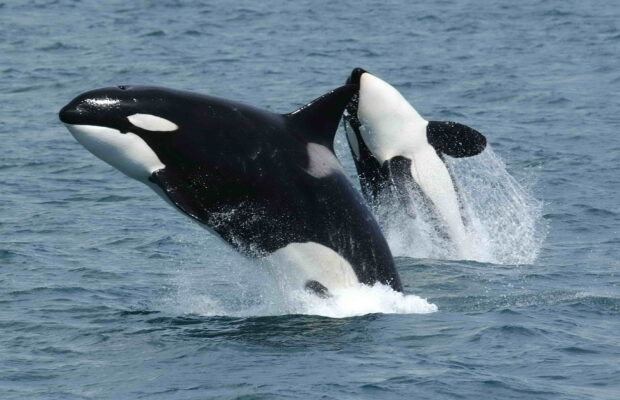Orcas have culture all their own

Culture has long been understood as a trait that separates humans from other animals. Humanity seems to believe that animals are lesser, have limited feelings and are driven only by instinct. The human species has long believed that we are the most complex species on the planet. though naturalists have also long observed and recognized other species display their own cultural ways. One of the most observable species, beyond humans for cultural traits, are orcas or killer whales.
Orcas have a culture, a complex culture that involves behaviors like hunting tactics, playing, language and the passing on of knowledge. These orca cultures can be so different from each other just like humans, depending on what part of the ocean and what land and human developments they are close to. Though, the main defining culture of an orca pod is that it is matriarchal, which means its leaders are female which consists of a main mother with daughters and their offspring. This is a delicate but ideal balance for orca pods in sustaining population growth.
According to a study by science magazine Current Biology, if pods that orca mothers produce contain too many males, the preferred matriarchal system becomes disrupted by too many male births, as they do not become independent as fast as female calves. Researchers found that this prolonged feeding and caring for males carries a huge reproductive cost for mothers. Limiting access to food and continued reproduction, it can be seen as a breakdown in their cultural system. Though, their cultures also vary by group, and region.
A few examples of these groups would be called Resident,Transient and Offshore orcas. These different groups of orcas range from place to place. Let’s dive into Resident. Residents live off of Alaska but are often closer to shores. Resident orcas almost only eat chinook salmon, and this is the only thing they eat because they just simply prefer it. Resident Orcas realize that the chinook salmon is best for them, and gives them sustaining energy. These orcas also prefer to eat with other members of the pod. Transients are found in the same waters as residents but like to swim the oceans freely. Transients also have bigger appetites, meaning they eat almost everything, marine life of all kinds. Last but not least is Offshore. Offshore tend to live in the upper Pacific area but also are known to have the largest range out of any of the types. Orcas live in these pods as differently as the various cultures of humans. Habits, customs and dialects can all be slightly different from each other.
An extraordinary trait that female orcas share with human females is the extension of life long after the eggs of the female have expired. Why is this extraordinary? Culturally and biologically it may represent the need for an older female orca to be a giver of knowledge, as human elder females do also.An example can be found in orca history off the coast of Australia. According to the Killer Whale Museum of Eden of Australia, a pod living off the coast of Eden, Australia, for nearly a 100 years helped fishermen hunt baleen whales. As each generation of three related orca pods, elder matriarchs passed down the knowledge to the next that it was in their best interest for the pod to help the humans hunt so that they would share the food right after the kill. This seemed to be easier for the orca pod, using less energy to make a kill on their own, they became accustomed to this method of hunting, as did the whalers.
On a funnier note of orca behavior, it was observed that in orca pods occupying the waters of Puget Sound off the coast of Washington state, a matriarchal female orca took to playing with a dead salmon for a few weeks and then wearing it on her head like a hat. Her pod eventually followed along, flipping dead salmon onto their heads as if wearing a salmon beanie. This trend spread to two other local pods, and as quickly as the trend was created, it was ended as soon as the original mother orca stopped wearing the salmon hat.
Naturalists, scientists, and nature photographers witness incredible examples of culture in the animal kingdom. Naturalist and professional nature photographer Heather Hughes-Baskey of British Columbia, lives amongst examples of animal culture in rural Campbell River, British Columbia. Regarding what she has observed in orca pods that she photographs near her home and on ocean expeditions, and what has surprised her, she had this to say, when asked this question.
As a professional nature photographer and naturalist, what have you witnessed in the observation and photographing of orca pods that surprised you?
One of the most exhilarating experiences I have ever had when observing and photographing orcas in the wild was in late March of 2022. I had gone out on the water for a half day tour. It was cold in March, and we were all bundled up. We had heard there might be Transient (Bigg’s) Orcas coming through the area that day, and were hoping to see a small pod or two. Well? We had almost three dozen whales gather together in what is sometimes referred to as a “T- Party.” This is where small transient pods gather into one large super pod and gather to hunt & socialize amongst each other. Transients are well known to travel in small matrilineal pods and once in a while, they will gather together into a super pod. I wasn’t surprised by the knowledge of the T-Party, but we were surprised on the water to have it happen to us and it was one of the best whale-watching experiences I have ever had. Just incredible to be in “orca soup” —they were everywhere—fins as far as you can see!
Orcas clearly want to party, like humans too! Gatherings and parties are definitely cultural tradition.Though humans are on top for being able to come up with cultures, trends, traditions and so much more. Yet it is clear that cultural creativity is not exclusive to humans. When humanity compares itself to animals’ ways, they may not be impressed by the simplicity of it, or may think it’s just typical instinctive animal behaviors. Animal culture is real, and it may be beneficial for humans to study and take note, just how well the animal kingdom gets along, even with cultural shifts, sibling rivalries for mother orca’s attention and dead salmon hat trends that are fashionable one day but not the next.









You must be logged in to post a comment Login